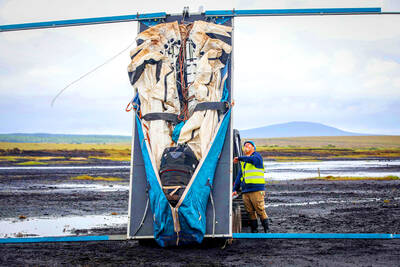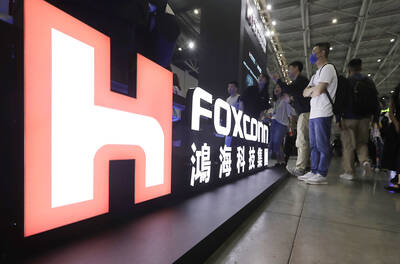Japan’s economy climbed out of a year-long recession in the second quarter, the government said yesterday, expanding 3.7 percent at an annual pace and joining Germany, France and other regions that appear to be emerging from the global financial crisis.
Economists and politicians sounded cautious, however, noting that the main driver of growth was exports and that domestic consumer spending remained fragile amid plunging incomes and rising unemployment.
The recovery in the April-June quarter was driven by robust demand for cars, video recorders and other electronics goods, government data showed. Shipments to China and other emerging markets were particularly strong, although exports to the US and Europe also showed modest recoveries.
Exports grew 6.3 percent from the previous quarter, the highest rate in seven years.
Government stimulus measures have also helped, such as cash handouts and incentives to buy ecological products.
Economists said the nascent recovery, however, could quickly run out of steam because domestic demand remains weak. Salaries are falling and the unemployment rate has risen to a six-year high of 5.4 percent as companies such as Toyota Motor Corp and Sony Corp have cut thousands of jobs.
“When you look at the numbers, the contrast between external demand and internal demand is as clear as night and day,” said Hiroshi Watanabe, economist with Daiwa Institute of Research in Tokyo. “With payments falling, it’s really hard to expect individual spending to hold up.”
During the quarter through June 30, compensation for employees dipped 1.7 percent, the data showed, while consumer spending edged up a tepid 0.8 percent.
Investors sent stocks plunging on dismay the numbers weren’t even stronger and on anxiety about Friday’s weak US consumer confidence report. The Nikkei 225 lost 3.1 percent to finish at 10,268.61.
The rebound in the world’s second-biggest economy came after a steep, year-long contraction in GDP, including a worst-ever drop in the final quarter of last year, when the economy shrank at a 13.1 percent pace.
The news from Japan comes amid signs that the global economy may be recovering from its slump. Last week, France and Germany, Europe’s two biggest economies, said they resumed growing in the second quarter, while Hong Kong also said it expanded after a year-long recession.
Economy and fiscal policy minister Yoshimasa Hayashi, however, warned that “risk factors” remained, including high unemployment and sluggish production.
“Production is still at a low level, and worries remain that employment conditions will worsen. So we must watch the downside risks,” he said on nationally televised news.

A proposed 100 percent tariff on chip imports announced by US President Donald Trump could shift more of Taiwan’s semiconductor production overseas, a Taiwan Institute of Economic Research (TIER) researcher said yesterday. Trump’s tariff policy will accelerate the global semiconductor industry’s pace to establish roots in the US, leading to higher supply chain costs and ultimately raising prices of consumer electronics and creating uncertainty for future market demand, Arisa Liu (劉佩真) at the institute’s Taiwan Industry Economics Database said in a telephone interview. Trump’s move signals his intention to "restore the glory of the US semiconductor industry," Liu noted, saying that

On Ireland’s blustery western seaboard, researchers are gleefully flying giant kites — not for fun, but in the hope of generating renewable electricity and sparking a “revolution” in wind energy. “We use a kite to capture the wind and a generator at the bottom of it that captures the power,” said Padraic Doherty of Kitepower, the Dutch firm behind the venture. At its test site in operation since September 2023 near the small town of Bangor Erris, the team transports the vast 60-square-meter kite from a hangar across the lunar-like bogland to a generator. The kite is then attached by a

Foxconn Technology Co (鴻準精密), a metal casing supplier owned by Hon Hai Precision Industry Co (鴻海精密), yesterday announced plans to invest US$1 billion in the US over the next decade as part of its business transformation strategy. The Apple Inc supplier said in a statement that its board approved the investment on Thursday, as part of a transformation strategy focused on precision mold development, smart manufacturing, robotics and advanced automation. The strategy would have a strong emphasis on artificial intelligence (AI), the company added. The company said it aims to build a flexible, intelligent production ecosystem to boost competitiveness and sustainability. Foxconn

STILL UNCLEAR: Several aspects of the policy still need to be clarified, such as whether the exemptions would expand to related products, PwC Taiwan warned The TAIEX surged yesterday, led by gains in Taiwan Semiconductor Manufacturing Co (TSMC, 台積電), after US President Donald Trump announced a sweeping 100 percent tariff on imported semiconductors — while exempting companies operating or building plants in the US, which includes TSMC. The benchmark index jumped 556.41 points, or 2.37 percent, to close at 24,003.77, breaching the 24,000-point level and hitting its highest close this year, Taiwan Stock Exchange (TWSE) data showed. TSMC rose NT$55, or 4.89 percent, to close at a record NT$1,180, as the company is already investing heavily in a multibillion-dollar plant in Arizona that led investors to assume